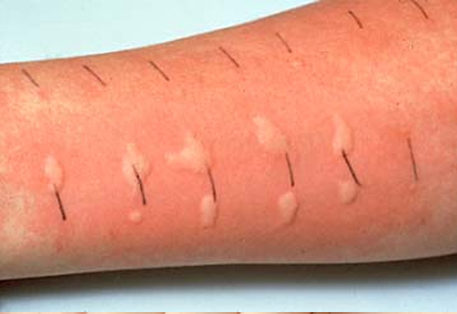
Skin testing is done over forearm. It is simpler to use, and less expensive. Skin testing is also known as "puncture testing" and "prick testing" due to the series of tiny puncture or pricks made into the patient's skin. Small amounts of suspected allergens and/or their extracts (pollen, grass, mite proteins, peanut extract, etc.) are introduced to sites on the skin marked with pen . A small plastic or metal device is used to puncture or prick the skin. If the patient is allergic to the substance, then a visible inflammatory reaction will usually occur within 30 minutes. This response will range from slight reddening of the skin to a full-blown hive (called "wheal and flare") in more sensitive patients similar to a mosquito bite. Interpretation of the results of the skin prick test is normally done by allergist on a scale of severity, with +/- meaning borderline reactivity, and 4+ being a large reaction. Doctor measures and records the diameter of the wheal and flare reaction. Interpretation by well-trained allergists is often guided by relevant literature.
If a serious life threatening anaphylactic reaction has brought a patient in for evaluation, an initial blood test prior to performing the skin prick test is preferred. Skin tests may not be an option if the patient has widespread skin disease or has taken antihistamines sometime the last several days.
Blood testing
Generally doctors test “Total IgE level" – Unfortunately it is not indicative of the specific allergen. Also, A low total IgE level is not adequate to rule out sensitization to commonly inhaled allergens. In our Hospital, we use a latest technology screening to identify specific IgE levels to about 80 allergens that are commonly seen in India. Only 2 ml blood is needed for this test.
Elimination/Challenge tests:
This testing method is utilized most often with foods or medicines. A patient with a particular suspected allergen is instructed to modify his/her diet to totally avoid that allergen for determined period of time. If the patient experiences significant improvement, he/she may then be “challenged” by reintroducing the allergen to see if symptoms can be reproduced.
Pulmonary Function test
We have installed 2 MIR Spirometers to assess Lung Functions in our centre
Pulmonary function tests are done to:
• Diagnose certain types of lung disease (especially asthma, bronchitis, and emphysema)
• Find the cause of shortness of breath
• Measure whether exposure to contaminants at work affects lung function
• Assess the effect of medication
• Measure progress in disease treatment
Spirometry measures airflow. By measuring how much air one can exhale, and how quickly, spirometry can evaluate a broad range of lung diseases.
Normal results
The results of spirometry tests are compared to predicted values based on the patient's age, gender, and height.
• FEV-0.5—50-60% of FVC
• FEV-1—75-85% of FVC
• FEV-2—95% of FVC
• FEV-3—97% of FVC
In general, a normal result is 80–100% of the predicted value.
Abnormal values are:
• mild lung dysfunction—60–79%
• moderate lung dysfunction—40–59%
• severe lung dysfunction—below 40%